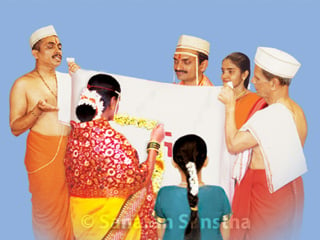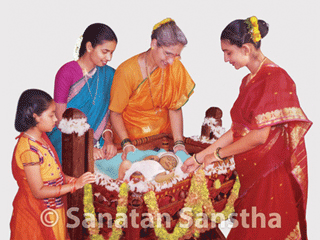Dharma preaches that the purpose of human birth is God-realisation. The religious scriptures therefore impart guidance on how to undertake spiritual practice so as to be able to get closer to God in every incident of life, right from birth till death. Life span from birth till marriage completes one cycle. A similar cycle is completed from the birth of a son/daughter to his/her marriage. This goes on generations after generations. These articles imparts knowledge on what sanskars should be performed to get closer to God in the sixteen rituals in life from conception to marriage. These sanskars later help in improving spiritual practice.
Hindu Dharma has advised sanskars to be performed during the sixteen principal events of life, so as to move closer to God. The most important of them being the ‘Vivah sanskar (Marriage sanskar)’!
To bury the umbilical cord at the time of birth, to install the deity of the pandal (mandapdevata) during the thread ceremony, while worshipping the deity of the pandal and Gourihar during marriage, so also when taking fire to the crematorium an earthen pot is used.
The sacred thread is held in the hand and chanting the Gayatri mantra ten times, is sprinkled with water charged with mantras. This endows it with the tej (absolute fire) element. The boy is then asked to wear it.
To prevent any obstacle from disrupting an auspicious occasion, it is begun with the worship of Lord Ganapati, a practice which is prevalent since the last century.
2% of all physical and psychological problems are constituted by defects in the ovum and womb, half of them being physical and the other half psychological in nature.
Jatakarma is performed to eliminate the defects in the foetus arising from intake of liquor (amniotic fluid) and to liberate the father who has glanced at the son’s face, from the three debts (to the ancestors, to the sages and to the deities) as well as the debt to society.






